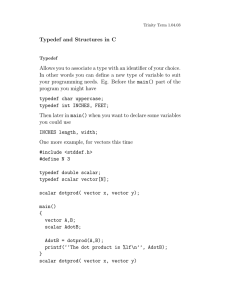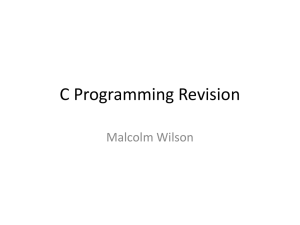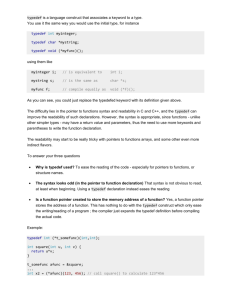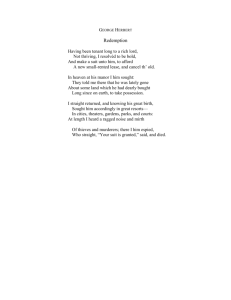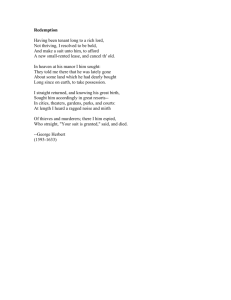Chapter 11
advertisement
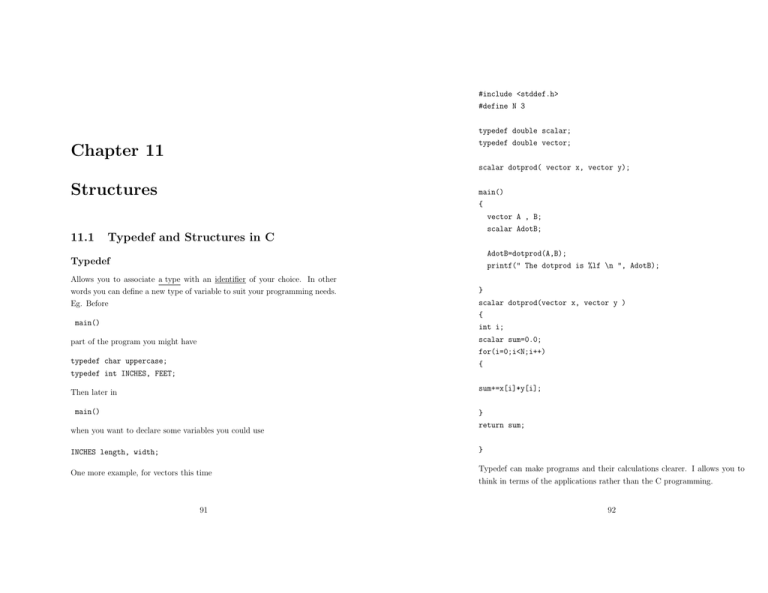
#include <stddef.h>
#define N 3
typedef double scalar;
typedef double vector;
Chapter 11
scalar dotprod( vector x, vector y);
Structures
11.1
main()
{
vector A , B;
scalar AdotB;
Typedef and Structures in C
AdotB=dotprod(A,B);
printf(" The dotprod is %lf \n ", AdotB);
Typedef
Allows you to associate a type with an identifier of your choice. In other
words you can define a new type of variable to suit your programming needs.
}
scalar dotprod(vector x, vector y )
{
int i;
Eg. Before
main()
part of the program you might have
scalar sum=0.0;
for(i=0;i<N;i++)
typedef char uppercase;
typedef int INCHES, FEET;
{
Then later in
sum+=x[i]*y[i];
main()
when you want to declare some variables you could use
}
return sum;
INCHES length, width;
}
One more example, for vectors this time
Typedef can make programs and their calculations clearer. I allows you to
think in terms of the applications rather than the C programming.
91
92
structures
Extend C from fundamental to derived types.
Example
A deck of cards. Each card is characterised by it suit (a character string)
and its numerical value (an integer). I would be nice if we could invent a
new variable type which contained both pieces of information - for writing a
C program to play poker.
More scientific/maths examples we have
• complex numbers which have a real and imaginary part
• planetary classifications which for each planet contain the name (char),
diameter (double), distance from the sun,....
• Mechanics a x velocity, y velocity and z velocity component
struct card{
int numeric_value;
char suit;
}c1,c2;
Now c1 and c2 are of type card. These are derived data-types.
Combining typedef and structures allows
typedef struct {
double re;
double im;
}complex;
This defines a new variable type called complex and it’s a structure with
members labeled re and im.
• for a location (char) storing its latitude and longitude
Accessing members of a structure
Back to the cards. The suit and numeric values can’t be stored in an
We shall use the the card structure to illustrate this.
For example if we want c1 to be the 3 of spades, then
array as they are different types. Structures have components called members
which can be different types.
For example
struct card{
int numeric_value;
c1.numeric_value = 3;
c1.suit=’s’;
In general struct_name.member_name is a simple variable just like an array
element.
A nice property - say we want c2 to be the 3 of spades too
char suit;
};
This defines a new type called card. Put this definition in a program before
main and we have a new type called card. This can be used like an
int, double,
to define as many variables of type card as you like.
A shortcut is
93
c2=c1;
copies each member of c1 to the corresponding member of c2 but you do not
have to do it term by term.
c2.numeric_value =c1.numeric_value;
c2.suit=c1.suit;
94
An array of structures (a deck of cards)
To declare all 52 cards as type struct card
which defines a new variable type called complex.
Now, write a function that adds 2 complex numbers.
1. Inputs: 2 complex numbers
struct card{
int numeric_value;
2. function returns a complex number
char suit;
}deck[52];
complex add_complex(complex a , complex b)
{
and we can enter these
complex sum;
deck[0].numeric_value = 1;
deck[0].suit=’c’;
sum.re=a.re+b.re;
sum.im=a.im+b.im;
return sum;
}
deck[1].numeric_value = 2;
deck[1].suit=’c’;
Also in this example a structure is passed as argument to a function and a
structure is returned by the function.
Just like a simple variable (double, int,..)
deck[2].numeric_value = 2;
deck[2].suit=’c’;
.
.
.
Pointers and Structures
Last bit on structures: how to avoid copying the entire structure to a function and then copying back to main the ’local’ function copy this becomes
deck[51].numeric_value = 13;
deck[51].suit=’s’;
11.1.1
computationally expensive.
An alternative is we use pointers.
difference between Call by Value and Call by reference (pointers)
A structure and a function
A pointer to a structure is the same as a pointer to any basic type.
Using pointers we can pass the address of a structure to the function
We will use the complex number struct to illustrate this. We defined
⇒ no local copy in function is needed.
typedef struct {
double re;
main()
{
double im;
}complex;
struct pointer_example{
95
96
int i;
double x;
}s,*p_s;
p_s = &s;
p_s->i=5;
p_s->x=1.1;
printf("s %d\n",s.i);
printf("p_s %d\n",p_s->i);
printf("*p_s %d\n",(*p_s).i);
printf("s %lf\n",s.x);
printf("p_s %lf\n",p_s->x);
printf("p_s %lf\n",(*p_s)->x);
}
97
